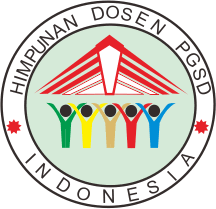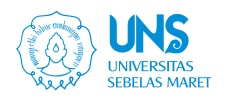Penerapan pembelajaran stad (student team achievement division) berbantuan media komik untuk meningkatkan keterampilan pemecahan masalah materi analisis data peserta didik kelas v sd
Abstract
This research aims to: 1) explore the implementation of the Student Team Achievement Division (STAD) learning model integrated with comic media to develop problem-solving skills in data analysis for fifth-grade students at SD Negeri Banyuanyar 1; and 2) enhance students’ problem-solving abilities in data analysis through the STAD model assisted by comic media. The study adopts a Classroom Action Research (CAR) approach, involving the classroom teacher and 28 students as participants. Data were gathered through observation, interviews, documentation, and tests, with triangulation employed to ensure data validity. An interactive data analysis method was used throughout the research. The results show a consistent improvement in students’ problem-solving performance, with the average score increasing from 50 in the pre-action stage to 68 in the first cycle, and further to 84 in the second cycle. Classical completeness also improved, rising from 32% during the pre-action phase to 68% in cycle 1, and reaching 86% in cycle 2. The study concludes that: 1) the STAD learning model combined with comic media is feasible and can be implemented effectively; and 2) the model significantly improves fifth-grade students’ problem-solving skills. Theoretically, the findings offer valuable insight into the integration of STAD and comic media within mathematics instruction. Practically, the use of comic media in the STAD model demonstrates clear benefits and positive impacts, serving as a useful reference for future educational research.
This research aims to: 1) explore the implementation of the Student Team Achievement Division (STAD) learning model integrated with comic media to develop problem-solving skills in data analysis for fifth-grade students at SD Negeri Banyuanyar 1; and 2) enhance students’ problem-solving abilities in data analysis through the STAD model assisted by comic media. The study adopts a Classroom Action Research (CAR) approach, involving the classroom teacher and 28 students as participants. Data were gathe
Keywords
References
[1] I. Maulana, A. Pambudi, Setyaning, and Z. Rohmah, “Perkembangan Matematika dalam Sejarah Peradaban Islam,” Pros. Konf. Integr. Interkoneksi Islam dan Sains, vol. 2, no. 1, pp. 115–119, 2018.
[2] R. Sulistyowati and J. Indrastoeti Siti Poerwanti, “Penerapan Model Pembelajaran Problem Based Learning Berbantuan Media Komik Untuk Meningkatkan Keterampilan Pemecahan Masalah Siswa Kelas V Sekolah Dasar,” Didakt. Dwija Indria, vol. 12, pp. 305–310, 2024.
[3] R. R. Solihin, T. T. D. Susanto, E. P. Fauziyah, N. V. I. Yanti, and A. P. Ramadhania, “The Efforts of Indonesian Government In Increasing Teacher Quality Based On PISA Result In 2022: A Literature Review,” Perspekt. Ilmu Pendidik., vol. 38, no. 1, pp. 57–65, 2024, doi: 10.21009/pip.381.6.
[4] N. Supriadi, W. Jamaluddin Z, and S. Suherman, “The role of learning anxiety and mathematical reasoning as predictor of promoting learning motivation: The mediating role of mathematical problem solving,” Think. Ski. Creat., vol. 52, no. February, p. 101497, 2024, doi: 10.1016/j.tsc.2024.101497.
[5] A. Rosyida, “Pengembangan Media Komik Berbasis Ctl Untuk Meningkatkan Hasil Belajar Siswa Sekolah Dasar,” J. Rev. Pendidik. Dasar J. Kaji. Pendidik. dan Has. Penelit., vol. 4, no. 3, p. 789, 2018, doi: 10.26740/jrpd.v4n3.p789-799.
[6] R. J. N. Petrus, J. Daryanto, and S. B. Kurniawan, “Analisis kecerdasan logis matematis peserta didik kelas V dalam menyelesaikan soal cerita matematika,” J. Didakt. Dwija Indria, vol. 12, no. 2, p. 53, 2023.
[7] D. Harefa et al., “Penggunaan Model Pembelajaran Kooperatif Tipe Jigsaw Terhadap Kemampuan Pemahaman Konsep Belajar Siswa,” Aksara J. Ilmu Pendidik. Nonform., vol. 8, no. 1, p. 325, 2022, doi: 10.37905/aksara.8.1.325-332.2022.
[8] L. Shofiyah, “STAD-Type Cooperative Learning in IPS Lessons in Elementary School,” SHEs Conf. Ser. 3 2251-2256, vol. 3, no. 3, pp. 1–6, 2020.
[9] I. Wulandari, “Model Pembelajaran Kooperatif Tipe STAD ( Student Teams Achievement Division) dalam Pembelajaran MI,” J. Papeda J. Publ. Pendidik. Dasar, vol. 4, no. 1, pp. 17–23, 2022, doi: 10.36232/jurnalpendidikandasar.v4i1.1754.
[10] J. Sriana and S. Sujarwo, “Analisis Model Pembelajaran Kooperatif Tipe Stad Dalam Meningkatkan Hasil Belajar Siswa,” Pedagog. J. Ilm. Pendidik., vol. 8, no. 1, pp. 39–51, 2022, doi: 10.47662/pedagogi.v8i1.245.
[11] E. Ambarningrum, S. Y. Slamet, and Karsono, “Pengaruh model pembelajaran student team achievment divisions (STAD) dan motivasi belajar terhadap kemampuan menulis puisi anak,” Didakt. Dwija Indria, no. c, pp. 1–5, 2019.
[12] U. Sudrajat, “Model pembelajaran student teams achievement divisions (STAD) untuk meningkatkan aktivitas dan hasil belajar PKn di kelas IV sekolah dasar,” J. Pendidik. Dasar, vol. 10, no. 1, pp. 25–32, 2022, doi: 10.20961/jpd.v10i1.62945.
[13] T. B. Agustina and T. S. Sumartini, “Kemampuan Representasi Matematis Siswa Melalui Model STAD dan TPS,” Plusminus J. Pendidik. Mat., vol. 1, no. 2, pp. 315–326, 2021, doi: 10.31980/plusminus.v1i2.904.
[14] I. Damopolii and S. R. Rahman, “The effect of STAD learning model and science comics on cognitive students achievement,” J. Phys. Conf. Ser., vol. 1157, no. 2, 2019, doi: 10.1088/1742-6596/1157/2/022008.
[15] Sugiyono 2016, Metode Penelitian Kuantitatif, Kualitatif, dan R&D, Bandung: Alfabeta.
Refbacks
- There are currently no refbacks.



